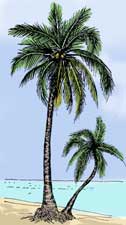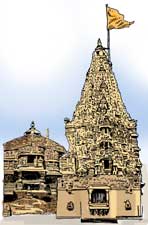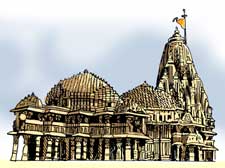
Dimdima
Online Children's Magazine from India

Dimdima
Online Children's Magazine from India

To the east and north of Kutch lie the bleak, desolate, salt-flecked desert of the Rann of Kutch.
The Rann comes to life in winter when hordes of migratory birds like the flamingos come from far-off places in Central Asia to escape the cold winter. The Rann is the only area in India where flamingos are still known to breed.
Unique to this region, is the reddish-grey or pale chestnut-coloured wild ass called the ghor khar. The Dhangadhra Sanctuary, covering an area of 4804 sq. km. was established in 1973 to protect the wild ass.
The Kutch coastline has a string of ports: Mandvi, Mundra, Jakhau, Lakhpat, Koteshwar and Kandla. Mandvi, the largest of these ancient ports had ships laden with dates, grain, timber, rhinoceros hides, cardamom, pepper, ginger, silks and drugs arriving from Malabar, Muscat and the African coast and taking in return cotton,cloth, sugar, oil, butter and alum. When these arrived, the rich merchant-fleet owners of Mandvi would climb the high tower near the lighthouse, called the Tower of Wagers, to stake fortunes upon whose ship would be sighted first.
Kandla is a natural harbour which has a Free Trade Zone, the first of its kind in the country. Near Kandla is located the largest salt works of Asia.
 At the westernmost tip of the peninsula lies Dwarka. The city Krishna built for the Yadavas is believed to be submerged in the sea. Interestingly, marine archaeologists have found evidence of a submerged city just off the coast.
At the westernmost tip of the peninsula lies Dwarka. The city Krishna built for the Yadavas is believed to be submerged in the sea. Interestingly, marine archaeologists have found evidence of a submerged city just off the coast.
The limestone city of Porbandar, where Mahatma Gandhi was born, lies along the coastal road to Somnath. According to local tradition, Porbandar was the ancient city Sudamapuri, which Lord Krishna had built for his friend,  Sudama.
Sudama.
Facing the Arabian Sea at Prabhas Patan stands the temple of Somnath, one of the 12 sacred Jyotirlingas of the country.
History has it that the temple was built in the first century A.D. The temple prospered with the rich offerings various kings made to the lord and became the richest, the biggest and the most sacred temple in the country. The lamps that lit the garbhagriha were studded with jewels and the temple's huge bell had a chain of solid gold. But it was this wealth that led to its ruin. It was plundered and destroyed in 1025 A. D. by Mahmud of Ghazni, who required a large caravan of elephants, camels and mules to carry away the wealth. The Temple was reconstructed by the rulers of Gujarat and Malwa. In the next seven hundred years, it was looted and destroyed six times. The present temple was consecrated on May 11, 1951, when Dr. Rajendra Prasad, the first president of free India, installed the jyotirlinga on the same foundation on which the earlier temples were built.
Last updated on :10/29/2004
Dimdima is the Sanskrit word for ‘drumbeat’. In olden days, victory in battle was heralded by the beat of drums or any important news to be conveyed to the people used to be accompanied with drumbeats.
Bharatiya Vidya Bhavan
K. M Munshi Marg,
Chowpatty, Mumbai - 400 007
email : editor@dimdima.com
Bharatiya Vidya Bhavan
505, Sane Guruji Marg,
Tardeo, Mumbai - 400 034
email : promo@dimdima.com
Dimdima.com, the Children's Website of Bharatiya Vidya Bhavan launched in 2000 and came out with a Printed version of Dimdima Magazine in 2004. At present the Printed Version have more than 35,000 subscribers from India and Abroad.